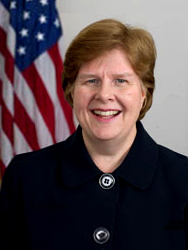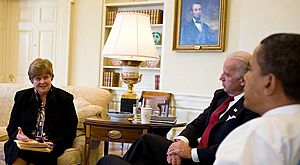Christina Romer facts for kids
Quick facts for kids
Christina Romer
|
|
|---|---|
 |
|
| 25th Chair of the Council of Economic Advisers | |
| In office January 29, 2009 – September 3, 2010 |
|
| President | Barack Obama |
| Preceded by | Edward Lazear |
| Succeeded by | Austan Goolsbee |
| Personal details | |
| Born |
Christina Duckworth
December 25, 1958 Alton, Illinois, U.S. |
| Political party | Democratic |
| Spouse | David Romer |
| Education | College of William & Mary (BA) Massachusetts Institute of Technology (MA, PhD) |
Christina Duckworth Romer, born on December 25, 1958, is a respected economist. She is currently a professor of economics at the University of California, Berkeley. She also served as the head of the Council of Economic Advisers for President Barack Obama. She left this important role on September 3, 2010.
Before the Obama administration started, Professor Romer worked with economist Jared Bernstein. They helped create the government's plan to help the economy recover from the 2008 recession. In a video from January 2009, she explained the details of a plan to create jobs. This plan was then sent to the United States Congress.
Contents
About Christina Romer
Early Life and Schooling
Christina Romer was born in Alton, Illinois. She finished high school in Canton, Ohio, in June 1977. She then went to The College of William & Mary, where she earned her bachelor's degree in economics in 1981. She continued her studies at the Massachusetts Institute of Technology (MIT). There, she earned her Ph.D. in 1985. After finishing her doctorate, she began teaching at Princeton University. In 1988, she moved to the University of California, Berkeley, becoming a full professor in 1993.
Her Work as an Economist
Professor Romer's early research looked at how much the economy changed over time. She compared economic ups and downs before and after World War II. She found that some of the reported decrease in economic changes was due to better ways of collecting data. However, she also showed that serious economic downturns, called recessions, have become less common.
She also studied the causes of the Great Depression in the United States. This was a very difficult economic time in the 1930s. Her work showed that the Great Depression was more severe in the U.S. than in Europe. She found that government spending plans during the "New Deal" were not enough to fix the problem. However, changes in money policy, like changing the value of the dollar, helped the U.S. economy recover.
Professor Romer has also studied how the Federal Reserve makes decisions about the economy. She looked at notes from their meetings to understand their choices. Her research suggests that good decisions by the Federal Reserve helped the economy grow steadily in the 1950s. She also found that the Fed could sometimes make better choices by listening more to their own expert staff.
More recently, she has researched how tax policies affect the government and the economy. She found that tax increases, especially those made to reduce government debt, can slow down economic growth. She also noted that tax cuts might not always reduce government spending. In fact, they might even lead to more spending later on.
Professor Romer has received many honors for her work. She was a vice president of the American Economic Association. She also received a Guggenheim Fellowship, which is a special award for talented individuals. She is a member of the American Academy of Arts and Sciences. She has also won awards for her teaching and for her vision in economic education. She is currently a co-director of a program at the National Bureau of Economic Research (NBER). She is also a member of the NBER Business Cycle Dating Committee, which officially decides when recessions begin and end. Her husband also serves on this committee.
Leading the Council of Economic Advisers
In November 2008, the team preparing for President Obama's administration asked Christina Romer to lead the Council of Economic Advisers (CEA). They chose her because of her deep understanding of the Great Depression. In late 2008, she worked with other economic advisors, Larry Summers and Peter R. Orszag. They suggested ideas for a plan to boost the economy.
Romer believed that a very large plan, around $1.8 trillion, was needed to fix the economic problems. However, the team decided on a smaller plan, about $800 billion, to make sure it would pass through Congress. This plan became the American Recovery and Reinvestment Act of 2009.

She left the CEA in September 2010 to go back to teaching at the University of California, Berkeley. She said she timed her departure so her youngest child could start high school in Berkeley.
In October 2011, Romer wrote an article in The New York Times. She suggested that the head of the Federal Reserve, Ben Bernanke, should focus on a goal called "nominal GDP." This idea was supported by other economists like Greg Mankiw and Robert Hall.
Family Life
Christina Romer is married to David Romer. He was her classmate at MIT and is also a professor in the economics department at the University of California, Berkeley. They have offices next to each other and often work together on their research. They have three children. Christina Romer is not related to the economist Paul Romer.
See also
 In Spanish: Christina Romer para niños
In Spanish: Christina Romer para niños


